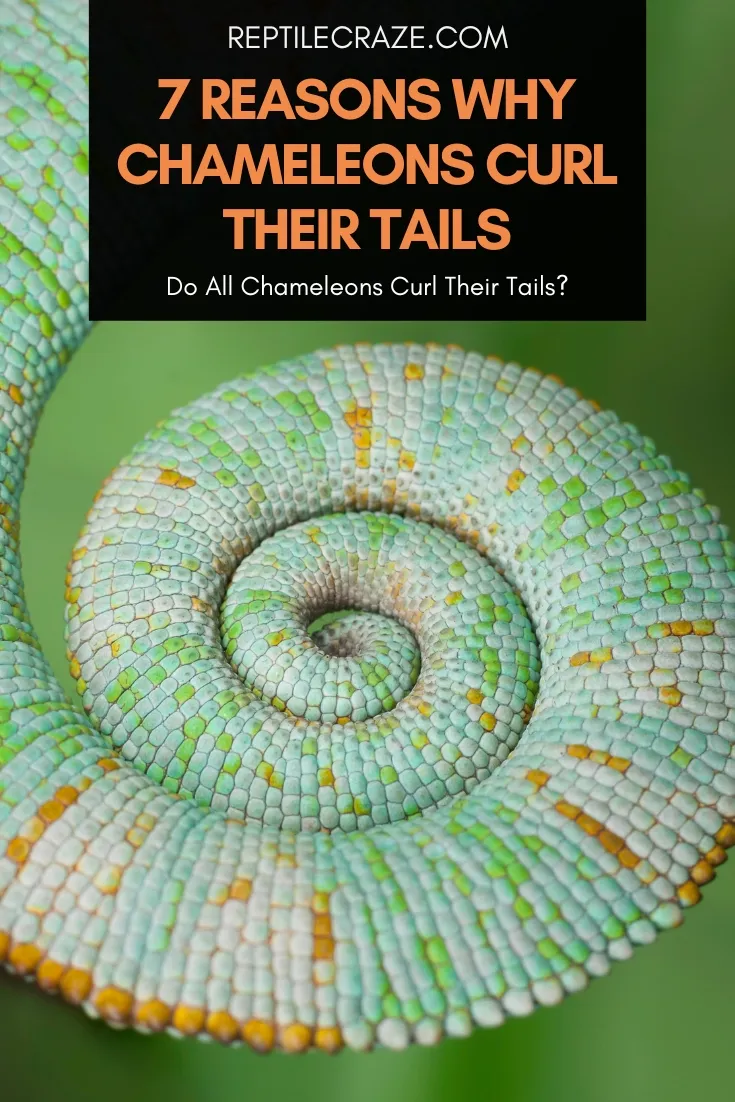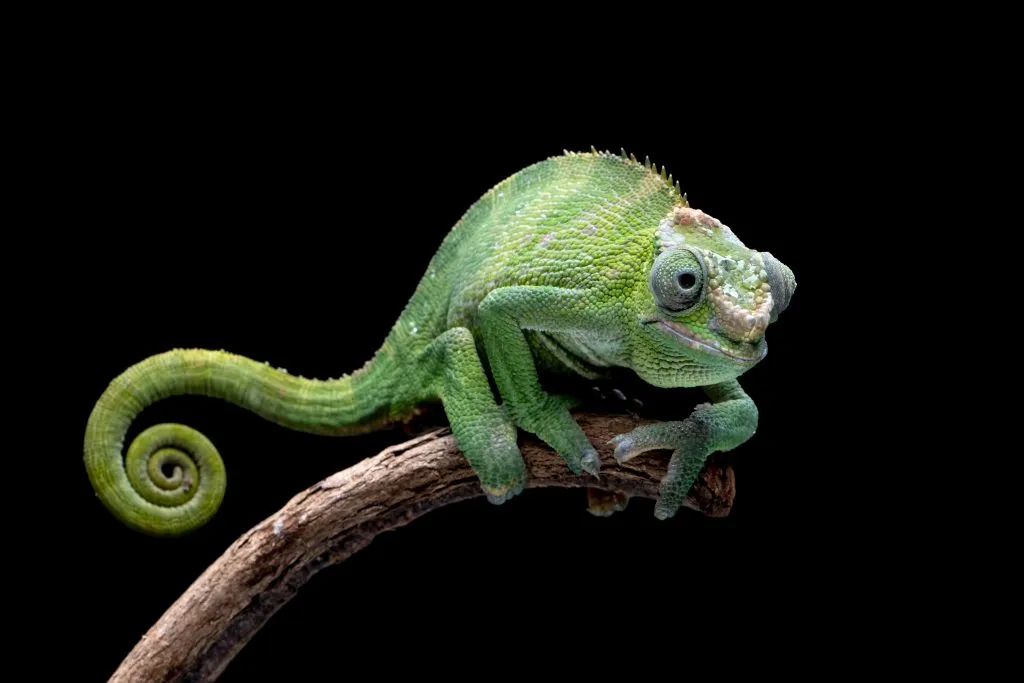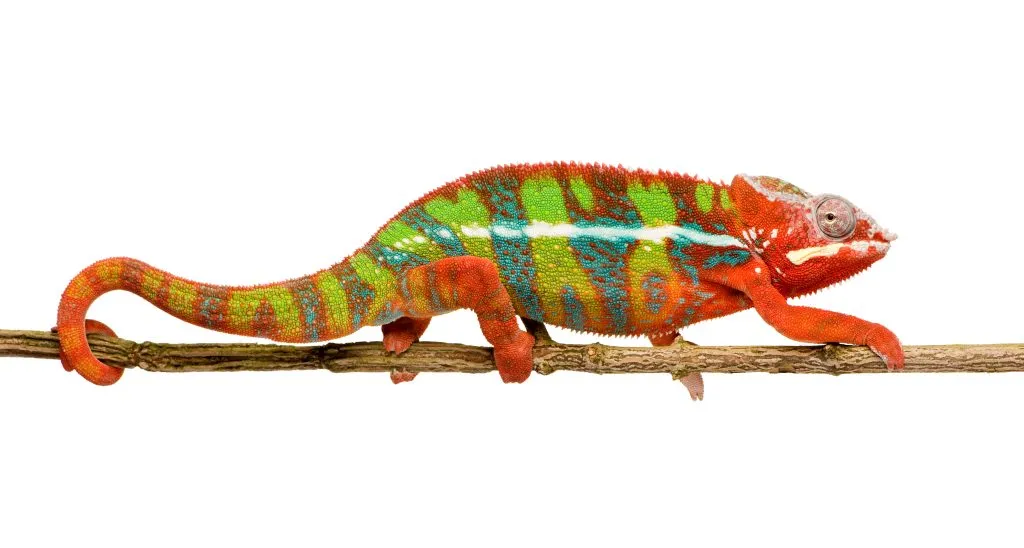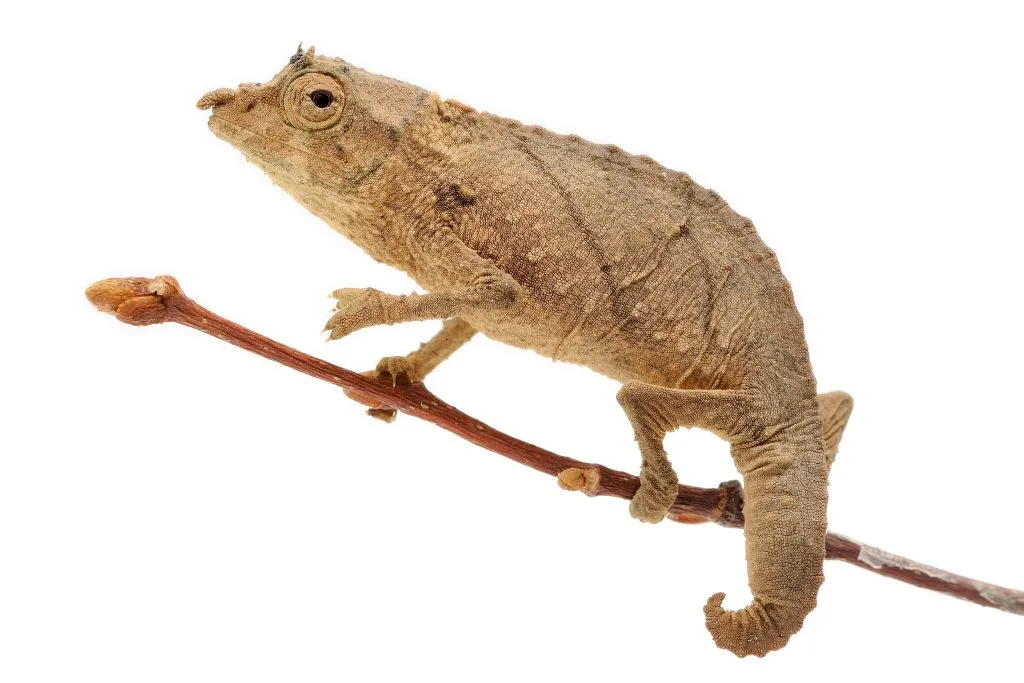
Chameleons are notorious for their ability to change colors. However, they have another remarkable characteristic: they can curl their tails! If you’ve ever seen a chameleon, you’ve probably noticed how it stands still with its tail tightly curled. Why does this reptile do that?
Chameleons have prehensile tails that function as a fifth limb. The main reason they curl their tails is to maintain balance and hold onto branches. Chameleons also use this ability as a communication means, a hunting technique, and as part of courtship behavior.
Whether you’re a chameleon enthusiast or have noticed your pet chameleon curling its tail frequently, you’re probably here to learn more about this ability. Keep reading to discover the reasons behind it!
Table of Contents
Why Do Chameleons Curl Their Tails?
A chameleon’s tail is biologically called a “prehensile tail.” This term points to an animal’s ability to use its curled tail for grasping and holding onto things.
If you’ve ever seen a monkey using its tail to hold onto things, you’ve already witnessed a prehensile tail in motion.
Chameleons, however, do not use their tails for locomotion purposes only (which we’ll discuss in detail below). There are so many other things hidden behind this behavior!
1. Balance
First and foremost, since most chameleons naturally inhabit trees and bushes, their tails are of utmost importance when it comes to remaining steady on thin branches.

In fact, scientists believe that almost all U.S. lizards’ survival chances (chameleons included) are highly dependent on their ability to curl their tails for balance purposes.
Moreover, chameleons often sleep with their tails curled for the same reason – to keep their balance and avoid falling off while sleeping.
Since chameleons do not grow their tails back, losing them equals falling off branches, running at reduced speed, and an increased risk of injuries.
2. Grasping and Clinging Aid
A chameleon’s tail is often regarded as its fifth limb. It serves as a grasping or clinging aid when the reptile requires additional locomotion help.
Their tails are so strong that they can support the animals’ weight. That’s why chameleons can move from branch to branch as monkeys do.
These lizards will also curl their tails around a branch if they want to stand still for long periods. This ability is often the cause behind people’s amazement in regard to this incredible reptile!
Chameleons often use their gripping and climbing abilities provided by their fifth limb when confronting predators or other aggressive chameleons. The long, curled tails offer them the flexibility required to perform escaping maneuvers.

3. Comfort and Trust
Many chameleon owners have noticed that their pets exhibit various feelings. These are sometimes concealed behind a curled-tail behavior. These color-changing reptiles often curl their tails when sleeping on their owner’s hands.
We already know that chameleons curl their tails when they fall asleep on branches. This helps them avoid falling off them. Why would they exhibit this behavior if they sleep in a relatively safe place, like their owner’s hands?
Upon observing their reptiles, several chameleon owners concluded that this is a way their lizards show signs of comfort and trust.
Sleeping with their tails curled might also be an instinctive behavior. However, we can regard this as an indication of trust until proven otherwise, can’t we?!
Check out this video which shows how a charming, brightly-colored chameleon can’t wait to get on its owner’s hands! Then, it curls its tail around its protector’s fingers!
4. Aggressivity and Defense
Chameleons curl their tail when they feel threatened. If this is accompanied by an open mouth, hissing, biting, and color change, your chameleon is undoubtedly showing signs of aggression.
Chameleons often exhibit this behavior during the breeding season. Males curl their tails, flatten their bodies, show bright colors, and turn sideways toward the other male. This way, it defends its territory and shows reproductive superiority.
Some chameleons curl their tails in response to threats. This ability is used as a defense mechanism because it makes them appear smaller, thus unnoticeable to potential predators.
Watch this video to see how chameleons defend their territory in the wild.
5. Stress and Discomfort
It is well-known among reptile owners that relaxed and happy chameleons usually keep their tails straight, especially if they’re just exploring their surroundings.
If the chameleon curls its tail when it’s awake and climbing or grasping on branches, it can be a sign that the reptile is stressed or upset about something.
This can happen if you’re new to each other and the reptile doesn’t feel comfortable in its environment. You may notice the chameleon curling its tail when you approach its terrarium.
You should also check whether the curling is the same as usual or if anything’s changed.
If the stress is caused by a sickness or an infection, your chameleon might not be able to curl its tail normally. Additionally, a part of it may remain uncurled.
Besides, some pet owners noticed a strange behavior in their chameleons when the weather got cold. Their pets remained hidden during the day, avoided light, and stayed with their tails curled.
In the end, they linked this behavior to low temperatures or sudden weather changes. This behavior was also observed after thunderstorms.
6. Courtship Behavior
Some chameleon species were seen curling their tails as part of courtship behavior. Male veiled chameleons, for example, flatten their bodies laterally and sway them, change their colors, showing a bright “palette,” and curl their tails.
Female chameleons, including the panther chameleon, sometimes curl their tails in response to courtship. You can observe this in the video added below.
Then, during mating, the chameleons curl their tails together if they’re not needed for maintaining balance.
A non-receptive female will turn dark brown or black mixed with white or yellow spots. If the male is persistent, the non-receptive female will curl its tail, hiss, or bite the potential mate. These are signs of aggression.
Therefore, if you’re trying to breed your chameleons in captivity, you can use their tails to learn whether the process is going smoothly. You might need to give them more time to get accustomed to each other.
7. Predation
Chameleons sometimes curl their tails while watching prey. You can observe that in the video linked below.
The chameleon curls its tail and swings its body. When it considers a moment favorable, it uses its long tongue to catch the prey.
Other chameleons use their curled tail during hunting if they move slowly toward prey. Their fifth limb helps the chameleon maintain their balance.
Keep watching the documentary we’ve shared to spot other chameleons with curled tails on a hunt!
Do All Chameleons Curl Their Tails?
Curling their tail offers chameleons an effective way of surviving in the wild and expressing their feelings. However, not all chameleons have developed this habit. It is believed that only arboreal species make extensive use of this curious ability.
Studies show that arboreal chameleons have longer and more curled tails than terrestrial species. The latter do not use their tails as much as the former.
Besides, arboreal chameleons’ gripping and climbing techniques are much more developed than those of terrestrial chameleons.
Two chameleon genera are known to have short non-prehensile or weakly prehensile tails: Brookesia and Rhampholeon.
1. Brookesia

Brookesia chameleons are commonly called leaf chameleons. They are terrestrial reptiles that place their tails on the substrate while moving.
Scientists confirmed that most Brookesia reptiles use their tails primarily to keep their balance on the ground when their specialized feet are of no help.
Studies show that the tail of Brookesia thieli consists only of 20 vertebrae. In contrast, most arboreal chameleons’ tails have 50 vertebrae. This proves that the tail of this terrestrial species is mobile only in the distal part.
This evidence shows that, unlike arboreal species, most Brookesia chameleons haven’t developed the ability of fully curling their tails. In fact, physical characteristics don’t even allow them to develop this behavior.
2. Rhampholeon

Rhampholeon reptiles are commonly called African pygmy chameleons. They are dwarf chameleons that live primarily on the ground through leaf litter or in low bushes.
Rhampholeon species have short tails that are either non-prehensile or weakly prehensile. This means they have neither the ability nor the need to curl their tails to move or survive in the wild.
- Enchi Ball Python: A Unique and Stunning Morph of Python regius - March 27, 2025
- Emerald Tree Monitor: The Enigmatic Green Guardian of the Rainforest - March 26, 2025
- The Egyptian Cobra (Naja haje): A Fascinating Serpent - March 25, 2025
